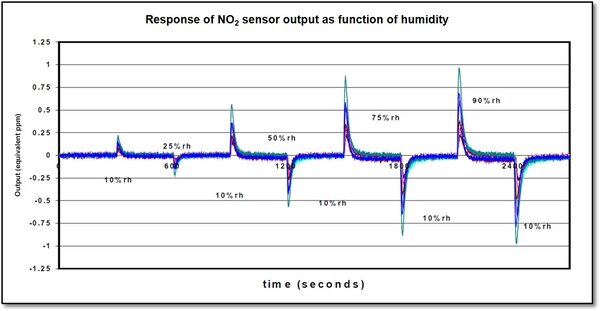Question:
One of our customers has purchased G460s with Ozone sensors. They want to know what is the best procedure when they see a reading after they have left the area. For example, they go into a space and get a reading of 0.05 ppm O3 and then leave the space. I have suggested that when they leave the space and they do a fresh air zero. They want to know if the sensor can become “saturated” and if so, how long does it take to recover in fresh air?
Answer:
The ozone sensor has characteristics that make it a little different from most other sensors. It’s a really good sensor, but it is helpful to understand some of the differences.
The resolution of the O3 sensor is 0.02 ppm. The measurement reading comes from extremely small changes in the electrical output of the sensor. Small changes in the electrical output signal that would be invisible with most other sensors are completely visible with the O3 sensor because of the sensitivity. The O3 sensor is also responsive to certain interfering gases. Ozone sensors are show a positive interference when exposed to other oxidizer gases like Cl2, ClO2 and NO2. These interfering oxidizer gases produce a rising reading. Because the O3 sensor is so much more sensitive per ppm of gas than Cl2 and NO2 sensors, when the O3 sensor is exposed to one of these other interfering gases it often causes the reading to exceed the maximum limit of the measurement range, and the instrument will display an “over limit” alarm in place of the O3 reading. The “over limit” alarm clears, and the instrument begins to show a numeric reading as soon as the signal drops back below the over limit concentration.
Some reducing gases, especially H2S, produce a negative interference. If the O3 sensor is exposed to H2S the reading may go negative. Fortunately, it takes quite a bit of H2S for this to happen when the instrument is in normal operation. A concentration of 20 ppm H2S will cause a healthy O3 sensor to show a negative reading of approximately –1.6 ppm.
Healthy O3 sensors recover rapidly from exposure to interferents and are not usually harmed by moderate exposure. However, the interference ratios can shift over the life of the sensor and can be influenced by the amount of interferent gas to which the sensor is exposed over time. When G460 instruments are equipped with both O3 and H2S sensors, the O3 sensor is exposed to 20 ppm H2S gas every time the instrument is bump tested. This chronic exposure can potentially affect the O3 sensor. Ozone sensors that fail calibration or show erratic or unstable readings in fresh air should be replaced.
For these reasons it is better, if possible, to avoid installing O3 and H2S sensors in the same instrument. The best solution is to install the O3 and H2S sensors in different instruments or use a single sensor instrument for O3 measurement.
The O3 sensor is also influenced by sudden shifts in humidity. Slow or modest shifts in humidity have little to no effect on the fresh air reading since the sensor stabilizes in the new humidity within a few seconds. If the humidity suddenly changes, as when you leave an air-conditioned room or take the instrument into a confined space, you often see a change in the fresh air reading while the sensor is adjusting to the new conditions. You can see a similar, substantially greater effect if you exhale on the sensor. Depending on whether the new location is more humid or less humid, the sensor shows a sudden increase or decrease in the reading when you enter or leave the area. This is followed by an equally steep change in the opposite direction as the sensor finished stabilizing in the new ambient conditions. In a healthy sensor these “humidity transients” are typically very brief. It normally takes only 15 or 20 seconds (or less) for the sensor to adjust to the new humidity. I’ve attached a graphic image that shows what these humidity transients look like. Because the transients have equal and opposite positive and negative components, they have no effect on time history STEL and TWA calculations.

The chart shows the effects of increasingly severe changes in humidity on the reading. You can see how quickly the sensor recovers, and how the positive and negative components in the response balance out to zero with regards to the exposure calculations.
If the fresh air readings do not stabilize on 0.00 ppm after a change in humidity, wait at least 30 seconds, or until the reading stops changing, and perform a fresh air adjustment. Make sure you are in fresh air before fresh air adjusting the sensor.
If the O3 sensor is exposed to other gases during calibration or bump testing procedures, the sensor needs to be allowed to recover completely before use. Watch the O3 reading as it falls or climbs after exposure to the interfering gas. Depending on the type and concentration of interfering gas, it may take up to 10 minutes or longer for the O3 sensor reading to completely stabilize at its fresh air value. Do not perform a fresh air zero until the reading stops changing in fresh air. If you don’t give the sensor enough time, and perform the fresh air adjustment too soon, you can wind up with a nonzero reading once the sensor finishes stabilizing. If this happens, all you need to do is perform another fresh air adjustment, but it is better to avoid the need.
The advice provided to the customer to perform a fresh air zero after leaving the space is correct. But please make sure the sensor has finished fully stabilizing in fresh air before making the adjustment.
Thank you for the question.
